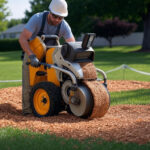
Stump Removal
The Comprehensive Guide to Stump Removal
Tree stumps are often the stubborn remnants of felled trees, lingering in yards and landscapes as unsightly obstacles. Whether you’re looking to reclaim space, enhance aesthetics, or prevent hazards, stump removal is a critical task for homeowners, landscapers, and property managers. This article explores the various methods of stump removal, their benefits and challenges, and practical considerations to help you decide the best approach. From manual techniques to professional services, we’ll cover it all, ensuring you have the knowledge to tackle this task effectively.
Why Remove a Tree Stump?
Tree stumps can pose several issues if left in place. Aesthetically, they disrupt the clean lines of a lawn or garden, making landscaping efforts look incomplete. Functionally, stumps can be tripping hazards, especially in high-traffic areas. They also attract pests like termites, ants, and fungi, which can spread to nearby plants or structures. Additionally, stumps can interfere with new plantings or construction projects, as their root systems may continue to spread underground source. Removing a stump ensures a safer, more usable, and visually appealing outdoor space.
Methods of Stump Removal
Several methods exist for stump removal, each with its own set of advantages, costs, and labor requirements. The best method depends on the stump’s size, location, and your budget.
1. Manual Stump Removal
Manual removal involves digging out the stump and its root system using hand tools like shovels, axes, and mattocks. This method is labor-intensive but cost-effective for small stumps (less than 12 inches in diameter). Start by digging around the stump to expose the major roots, then cut them with a saw or loppers. Once the roots are severed, you can pry the stump out with a pickaxe or shovel.
Pros: Low cost, no chemicals or heavy equipment needed.
Cons: Physically demanding, time-consuming, impractical for large stumps.
2. Stump Grinding
Stump grinding is one of the most popular professional methods. A stump grinder, a machine with a rotating cutting disc, chips away the stump and roots to below ground level. This leaves behind wood chips that can be used as mulch or removed. Grinding is efficient and minimally invasive, making it ideal for residential yards source.
Pros: Fast, effective for most stump sizes, minimal soil disturbance.
Cons: Requires specialized equipment, may not remove deep roots.
3. Chemical Stump Removal
Chemical stump removers use compounds like potassium nitrate to accelerate wood decomposition. You drill holes into the stump, apply the chemical, and wait—often weeks or months—for the stump to soften. Once decayed, the stump can be broken apart or burned (where permitted).
Pros: Minimal physical effort, inexpensive.
Cons: Slow process, potential environmental concerns, not suitable for immediate removal.
4. Burning
Burning involves drilling holes in the stump, filling them with fuel (like kerosene), and setting it alight. This method reduces the stump to ash but requires careful monitoring to prevent uncontrolled fires. Local regulations often restrict burning, so check with authorities first.
Pros: Effective for complete removal, low cost.
Cons: Fire hazard, slow, may be illegal in some areas.
5. Excavation with Heavy Machinery
For large stumps or those in open areas, an excavator or backhoe can dig out the entire stump and root ball. This method is quick but disruptive, often requiring significant soil replacement and landscaping afterward.
Pros: Fast, thorough.
Cons: Expensive, damages surrounding area, impractical for small yards.
Choosing the Right Method
Selecting a stump removal method depends on several factors:
- Stump Size: Small stumps are manageable with manual or chemical methods, while large ones often require grinding or excavation.
- Location: Stumps near structures or utilities may rule out heavy machinery or burning.
- Budget: Manual and chemical methods are cheapest, while grinding and excavation involve higher costs.
- Timeline: Grinding and excavation offer immediate results, whereas chemical removal or burning takes longer.
For most homeowners, stump grinding strikes a balance between cost, speed, and effectiveness. However, consulting a professional arborist or landscaper can help tailor the approach to your specific needs.
DIY vs. Professional Stump Removal
DIY stump removal is tempting, especially for budget-conscious homeowners. Manual removal or chemical treatments are accessible to novices, but they carry risks. Improper digging can damage underground utilities, and chemical misuse may harm nearby plants. Stump grinding, while effective, requires renting or purchasing specialized equipment, which can be costly and dangerous without training.
Hiring a professional ensures safety and efficiency. Professionals have the tools, expertise, and insurance to handle complex jobs, particularly for large or awkwardly placed stumps. Costs vary widely—grinding typically ranges from $100 to $400 per stump, depending on size and location—but the investment saves time and reduces risk source. If you opt for DIY, prioritize safety: wear gloves, goggles, and sturdy boots, and verify utility locations before digging.
Post-Removal Considerations
After removing a stump, you’ll need to address the site. For ground stumps, fill the hole with topsoil and seed it with grass or plant new vegetation. Wood chips from grinding can be left as mulch or removed for a cleaner look. If the stump was diseased, remove all debris to prevent fungal spread. Monitor the area for root regrowth, as some species, like poplars, may sprout new shoots.
Environmental and Legal Considerations
Before removing a stump, check local regulations. Some areas restrict burning or chemical use, and large-scale excavation may require permits. If the stump is on a property line or public land, consult neighbors or municipal authorities. Environmentally, avoid overusing chemicals, and consider recycling wood chips as mulch to minimize waste.
Conclusion
Stump removal is a practical step toward a safer, more attractive landscape. Whether you choose manual labor, chemical treatments, or professional grinding, understanding the methods and their implications ensures the best outcome. Small stumps may be a weekend project, but larger or hazardous ones often warrant professional help. By weighing your options and planning carefully, you can reclaim your yard and enjoy a stump-free space for years to come.


